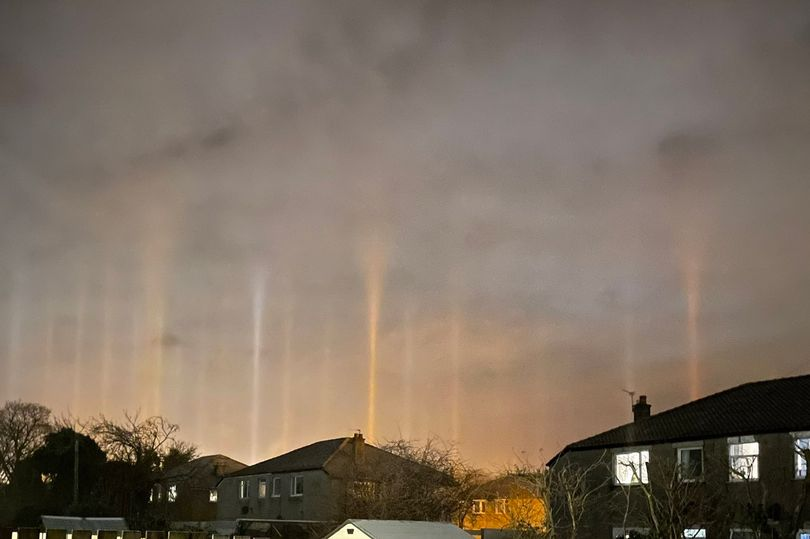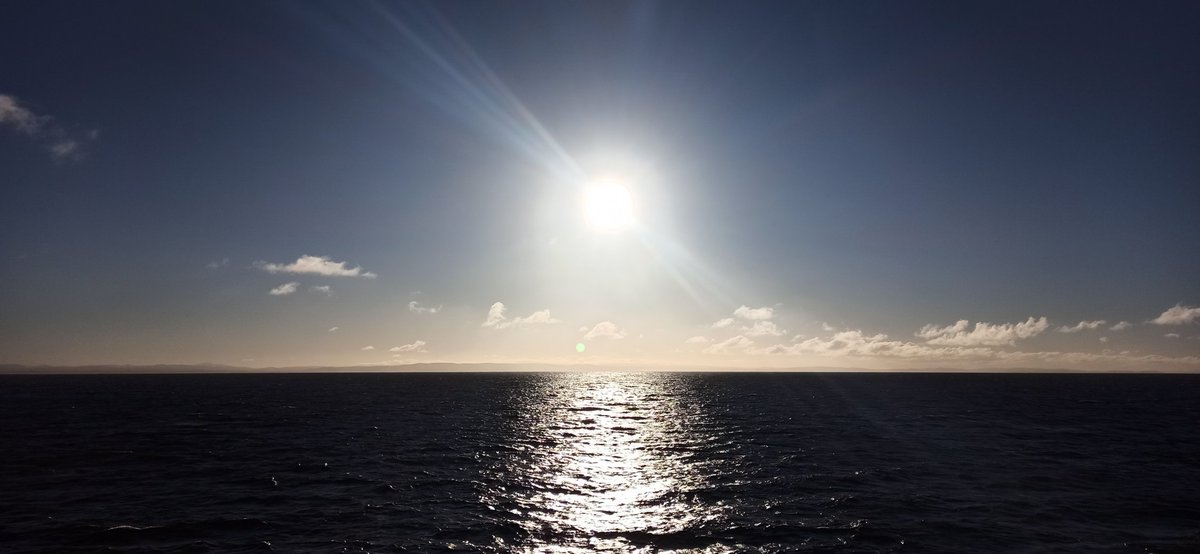In January of this year, photos started bouncing round the internet of this deeply weird thing happening in the sky above Glasgow. Photoshop trickery?
The bizarre truth:
- yes, everyone really saw these
- no, they're not faked or manmade
- they absolutely don't exist.
🧵
1/
The bizarre truth:
- yes, everyone really saw these
- no, they're not faked or manmade
- they absolutely don't exist.
🧵
1/

Here's the same thing happening above London (the other one, in Ontario, Canada) in 2018.
Again: these *aren't* spotlights shining upwards. They alse aren't the Northern Lights.
Also, they aren't actually there, even though everyone can see them.
Deep, deep weirdness.
2/
Again: these *aren't* spotlights shining upwards. They alse aren't the Northern Lights.
Also, they aren't actually there, even though everyone can see them.
Deep, deep weirdness.
2/

From a year early, again in Ontario (North Bay this time):
Yes, they come in different colours too.
Really gorgeous, right? Like an incredibly relaxing version of fireworks that even dogs could get behind.
(And yes, dogs should be able to see them too.)
3/
Yes, they come in different colours too.
Really gorgeous, right? Like an incredibly relaxing version of fireworks that even dogs could get behind.
(And yes, dogs should be able to see them too.)
3/

But there are different levels of unreality at work here.
The light creating this effect certainly exists. And the optical conditions making us see these pillars of light - they exist too.
But the columns themselves?
They just aren't there.
4/
The light creating this effect certainly exists. And the optical conditions making us see these pillars of light - they exist too.
But the columns themselves?
They just aren't there.
4/

This stunning example from weather enthusiast @TomPurdyWI is truly magnificent.
I would have sat there until all my extremities turned numb - which would have only taken minutes. This effect relies on very cold weather...
Okay, time for the science.
5/
I would have sat there until all my extremities turned numb - which would have only taken minutes. This effect relies on very cold weather...
Okay, time for the science.
5/

The atmospheric optical illusion known as a Light Pillar relies on ice crystals in the air, drifting slowly downwards.
Most are flat & hexagonal, & most align themselves horizontally. A slow rain of tiny fancy-gastropub dinner plates, made of ice...
6/
Most are flat & hexagonal, & most align themselves horizontally. A slow rain of tiny fancy-gastropub dinner plates, made of ice...
6/

...and the ones aligned *just so*...they act like mirrors.
They catch the light from somewhere distant and bounce it into your eyes.
But you mainly see the light from crystals at a certain distance from you. Different heights - same distance.
7/
They catch the light from somewhere distant and bounce it into your eyes.
But you mainly see the light from crystals at a certain distance from you. Different heights - same distance.
7/

Looking at this diagram again (via lwpetersen.com/atmospheric-op…):
The dashed line is the illusion we see. It's our interpretation of the very real photons hitting our retinas.
And it creates a pillar of light that isn't really there.
I mean, this is barmy, right?
8/
The dashed line is the illusion we see. It's our interpretation of the very real photons hitting our retinas.
And it creates a pillar of light that isn't really there.
I mean, this is barmy, right?
8/

When you see light pillars, like these over Pinedale, Wyoming (pic. David J. Bell), you're really seeing reflected light from ice crystals hanging in the air halfway between you & where these pillars *appear* to be.
You won't believe it at the time, though. (I wouldn't.)
9/
You won't believe it at the time, though. (I wouldn't.)
9/

If you're thinking 'Does this happen with sunlight and moonlight too?' then full marks awarded!
This is a Sun Pillar over Norway, via apod.nasa.gov/apod/ap180606.….
10/
This is a Sun Pillar over Norway, via apod.nasa.gov/apod/ap180606.….
10/

And here is a Moon Pillar over Antarctica, in a photo by Daniel Michalik, a research fellow at the European Space Agency.
*Wildly* beautiful.
11/
*Wildly* beautiful.
11/

Tragically, I'm about to be kicked out of the coffeeshop I'm writing in. Time to wrap this up.
But I'll soon be writing about all this in my @SubstackInc newsletter, 'Everything Is Amazing'. Want more? Sign up!
everythingisamazing.substack.com
Thanks for reading. :) #YayScience
But I'll soon be writing about all this in my @SubstackInc newsletter, 'Everything Is Amazing'. Want more? Sign up!
everythingisamazing.substack.com
Thanks for reading. :) #YayScience
Final point: where I haven't given credit in the thread to their original photographers and their *amazing* work here (none of these pics are mine except his one), I will be doing so fully in my upcoming newsletter.
Photographers deserve full credit in all cases.
Ta.
Photographers deserve full credit in all cases.
Ta.

Update:
A beautiful example here, courtesy of @_TheGeoff:
A beautiful example here, courtesy of @_TheGeoff:
https://twitter.com/_TheGeoff/status/1466804452309016579
Further update! This pic's by @hanshovmoller, and taken in Sweden this January. Feast your eyes, folks. What a stunner.
https://twitter.com/hanshovmoller/status/1466901865468239881
Since this thread is currently exploding in a way I was NOT expecting (good lord), a few other optical illusion threads you may enjoy:
- the "you can't unsee this" hilarity of pareidolia:
- the floating oddness of fata morgana:
- the "you can't unsee this" hilarity of pareidolia:
https://twitter.com/Mikeachim/status/1452271101095120897
- the floating oddness of fata morgana:
https://twitter.com/Mikeachim/status/1448319069988532233
And even more threads!
1/ The greatest travel journalism hoax in British history:
2/ An imaginary American town that refused to stay fake:
3/ Why all our maps could be the wrong way round:
1/ The greatest travel journalism hoax in British history:
https://mobile.twitter.com/Mikeachim/status/1392468208922337280
2/ An imaginary American town that refused to stay fake:
https://mobile.twitter.com/Mikeachim/status/1412780349638250497
3/ Why all our maps could be the wrong way round:
https://mobile.twitter.com/Mikeachim/status/1419266460820680704
Also: a bit off-thread, but since so many gamers are here shouting "loot boxes!", here's a plug for my favourite game, #TheLongDark, from @HinterlandGames & @RaphLife:
store.steampowered.com/app/305620/The…
It'll make you feel much of the cold, glittery wonder in the photos in this thread.
store.steampowered.com/app/305620/The…
It'll make you feel much of the cold, glittery wonder in the photos in this thread.
And a final shout-out to @StephNx79, whose photo is at the top of this thread, which started me down this whole fascinating rabbit-hole of optical delightfulness:
https://twitter.com/stephnx79/status/1346928233120411648?lang=en(Apologies to Steph that I didn't spot their equally viral tweet until now!)
And *finally* finally - here's my writeup of the whole thing, with a few more pics + additional metaphysical weirdness:
everythingisamazing.substack.com/p/the-best-vir…
Thanks for reading this thread! (What a whopper it's become, whew.)
everythingisamazing.substack.com/p/the-best-vir…
Thanks for reading this thread! (What a whopper it's become, whew.)

Bonus atmospheric optical shenanigans: fogbows! I had no idea these existed: bbc.co.uk/news/uk-englan… (h/t @hellobensalt)
*Update*: My final optical illusions thread just went up - and it's a mindboggling one:
https://twitter.com/Mikeachim/status/1483422642849947651
• • •
Missing some Tweet in this thread? You can try to
force a refresh

















